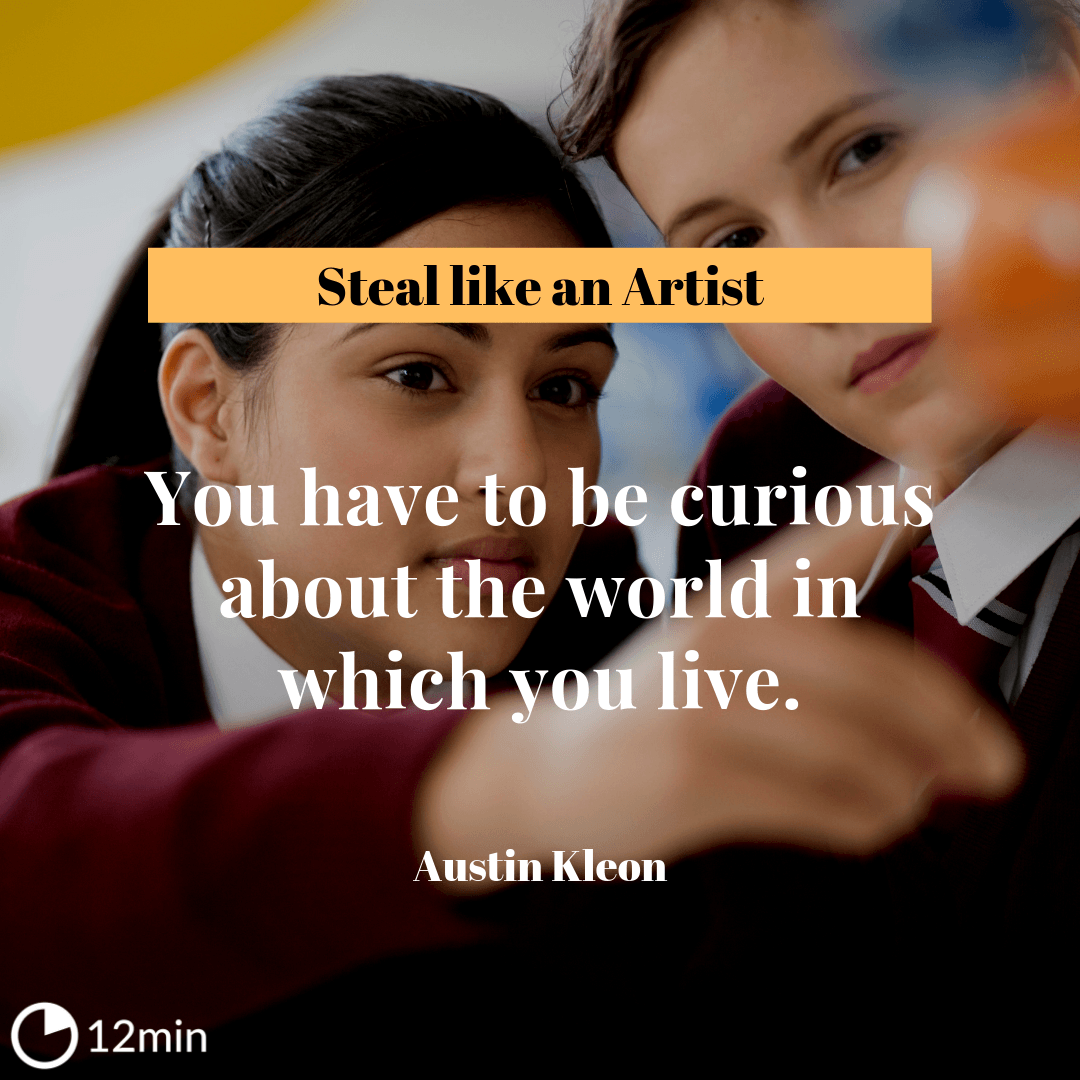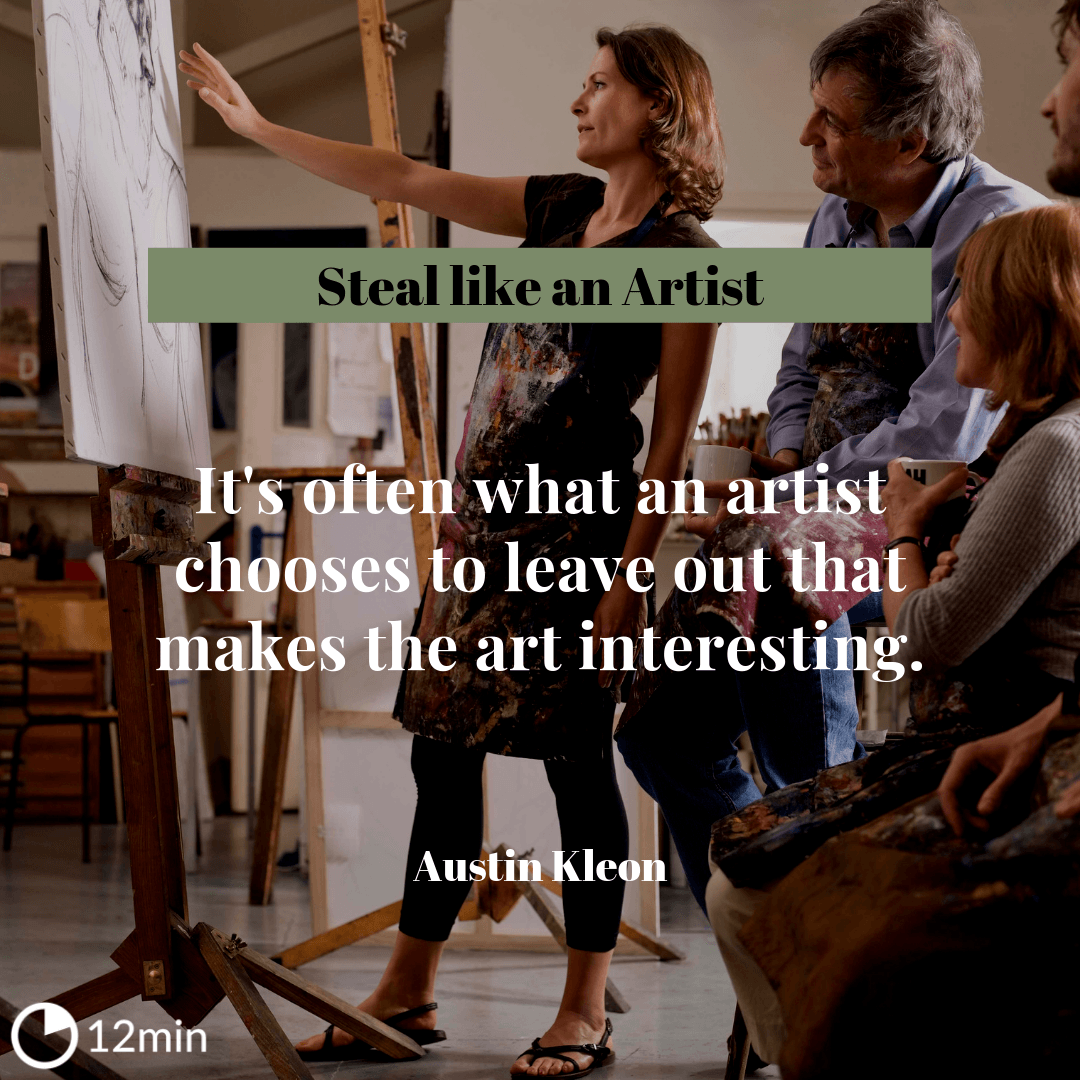Steal like an Artist Summary

6 min read ⌚
10 Things Nobody Told You About Being Creative
When it comes to art, stealing is legal… as long as it’s done in an elegant and creative way.
The world doesn’t need a new Einstein but sure does require individualism because the population has lost its uniqueness. The collective opinion prevails in every country.
Steal Like an Artist is one of a kind book supported by clear and concise book summary from GetNugget. So what’s the message from Austin Kleon? – Creativity is not a talent; it is like breathing; it suits everyone.
A platform for the digital time, masterminds of today declare that technology can endanger those creative jobs alluding to artists, writers, painters, etc. Are we robots? – If not, find your inner artistic side and become one with it!
Let’s take one step further into analyzing the word “stealing.” Stealing doesn’t always refer to money or items. Instead, the author clarifies the theory of exceptional artists; how they managed to influence others and how they cope with it.
This book summary will also give you a hint on how to handle different types of situation – individually. Awake that inner beast in you, don’t become a dependent person!
“Those who do not want to imitate anything, produce nothing.” (Salvador Dali)
So what’s Austin Kleon ’s perspective on creativity theft?
Starting exactly from the same premise as Salvador Dali’s, the American writer and artist Austin Kleon succeeds in delivering another brilliant book. And this one is straightforwardly entitled Steal Like an Artist.
It’s a New York Times bestselling manifesto of creativity in the digital age, most probably due to Austin Kleon’s signature honest writing style.
SOURCE OF CREATIVITY / STEAL LIKE AN ARTIST
Artists aren’t magicians.
“Steal Like an Artist Summary”
Austin Kleon shares his personal experience and his strategy of achieving self-contentment towards his professional career.
The key concept of Steal Like an Artist is ingeniously revealed by the title itself.
Austin Kleon preaches an intelligent way of imitating art, but still delivering something new.
As the Bible says, “There is nothing new under the sun” (Ecclesiastes 1:9). Kleon expresses his belief that everything has already been done with respect to art.
New art is just a reinterpretation, a reconfiguration, of previous artistic manifestations.
Kleon structured his book in 10 mini-chapters which give every aspiring artist an extremely powerful and useful plan of action.
He decided to unravel “The 10 Things Nobody Told You about Being Creative” within the contents of his book.
In the first chapter, “Steal Like an Artist”, we are introduced to the concept of imitation in art. As disturbing as it may be for artists to hear this, Kleon strongly affirms that:
“Nothing is original… embrace influence instead of running away from it.”
He also hints at what he actually means by “stealing like an artist”. He encourages us to get inspired by the people we admire and to imitate them in a personal way. How can we do this? By bringing our own “feel” into it:
“You’re only going to be as good as the stuff you surround yourself with.”
This chapter also exposes Kleon’s “genealogy of ideas”, which states that “every new idea is just a mashup or a remix of one or more previous ideas”.
You’ll also find out how important is to be permanently curious and hungry for information as an artist: “You have to be curious about the world in which you live… Google everything”.

In the second step of his plan of action, Kleon emphasizes the idea of beginning to actually make stuff until we discover our inner self: “It’s in the act of making things and doing our work that we figure out who we are”. Being involved in the working process and exploring as much as possible will ultimately lead to finding our own voice: “Nobody is born with a style or voice.”
The key concept of the third chapter, “Write the Book You Want to Read”, is revealed as the basic rule Kleon applies to his own life: “do the work you want to see done”. Putting all your energy into making the things you love and you feel most attracted to is a great philosophy to follow.
In this increasingly digitized world, Austin Kleon gives his readers advice on how to go back to the roots and “use their hands”, which “are the original digital devices”.
Consequently, the fourth chapter of Steal Like an Artist contains a firm decree for aspiring artists to disconnect from their computers and gadgets and start creating things with their hands: “computers are alienating because they put a sheet of glass between you and whatever is happening”.
Kleon also stresses the significance of getting your body involved in the creative process that you pursue: “You need to find a way to bring your body into your work.”
In the fifth chapter of his book, Kleon shares one very relevant aspect he has learned in his life so far: “It’s the side projects that really take off.”
He offers a very simple, yet meaningful, piece of advice: “Practice productive procrastination”. And he encourages all artists to “take time to be bored”, because “Creative people need time to just sit around and do nothing”.
Kleon also talks about the importance of hobbies, and insists that we should keep all the passions in our life:
Don’t throw any of yourself away.
The sixth step of Kleon’s clever guide focuses on one specific aspect that is outrageously significant whilst developing an artistic career: creating good work and getting it in front of the people.
In the author’s view, the process of sharing your work is indispensable to achieving success: “When you open up your process and invite people in, you learn.”
Where we choose to live still has a huge impact on the work we do… It helps to live around interesting people” – this is the essence of the seventh chapter. In order to enhance our creativity, we are given one simple solution: traveling and getting disconnected from our daily routine:
Your brain gets too comfortable in your everyday surroundings. You need to make it uncomfortable.
A devoted promoter of the fact that you must permanently “nourish” and pursue a generous behavior, Kleon simply asks us to be nice in order to enjoy an abundant and prosperous professional career.
Thus, the eighth chapter exposes the importance of having a kind attitude when interacting with others.
Steal Like an Artist(function(d,id){if(d.getElementById(id))return;var scr=d.createElement(‘script’);scr.src=’https://widget.12min.com/v0.2.0/widget.js’;scr.id=id;d.body.appendChild(scr);})(document,’12min-widget-sdk’);window.twelveminInit=function twelveminInit(){};
You’ll find out useful information about how you should behave on the Internet towards other people, and how you should express your admiration for others’ work: “If you truly love somebody’s work, you shouldn’t need a response from them”.

Kleon purposefully begins his ninth chapter with a quote from Gustave Flaubert:
Be regular and orderly in your life, so that you may be violent and original in your work.
He goes on to explain the necessity of establishing a routine in our everyday life, in order to increase our creative performance: “Establishing and keeping a routine can be even more important than having a lot of time.
He also discusses some other significant aspects, such as taking care of your own body, keeping your day job, or marrying well.
The final chapter of Steal Like an Artist revolves around the idea that “Creativity is Subtraction”. Time for another great lesson, this time on how to “choose what to leave out” when it comes to your art: “It’s often what an artist chooses to leave out that makes the art interesting.”
Even though art and constraints may seem like antithetic concepts, Austin Kleon brings them together into his innovative and unique perception: “When it comes to creative work, limitations mean freedom”.
You may not be the next Salvador Dalí, but you have the right to aspire to greatness. There is no such thing as lack of inspiration. It’s all about looking at the right thing, and not being afraid to allow yourself to be free and inspired.
So, steal! Steal smartly, steal bravely, and steal creatively. And in the end, you may just be amazed by your own work.
Like this summary? We’d Like to invite you to download our free 12 min app, for more amazing summaries and audiobooks.








